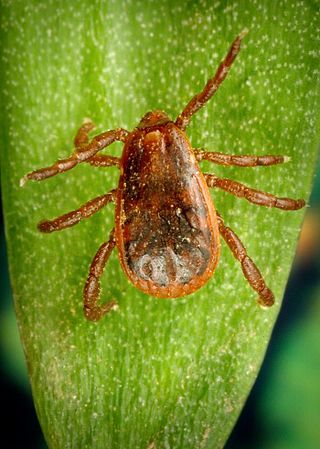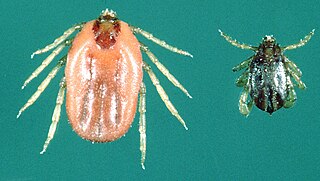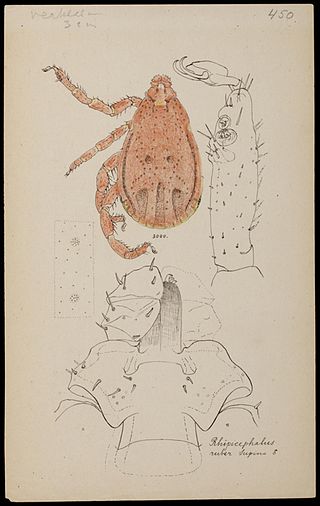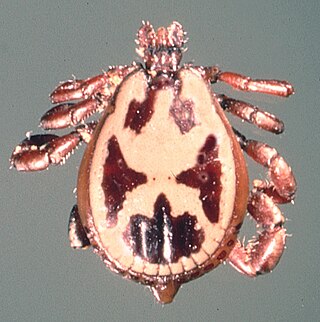
Ticks are parasitic arachnids of the order Ixodida. They are part of the mite superorder Parasitiformes. Adult ticks are approximately 3 to 5 mm in length depending on age, sex, species, and "fullness". Ticks are external parasites, living by feeding on the blood of mammals, birds, and sometimes reptiles and amphibians. The timing of the origin of ticks is uncertain, though the oldest known tick fossils are from the Cretaceous period, around 100 million years old. Ticks are widely distributed around the world, especially in warm, humid climates.

Rhipicephalus sanguineus, commonly called the brown dog tick, kennel tick, or pantropical dog tick, is a species of tick found worldwide, but more commonly in warmer climates. This species is unusual among ticks in that its entire lifecycle can be completed indoors. The brown dog tick is easily recognized by its reddish-brown color, elongated body shape, and hexagonal basis capituli. Adults are 2.28 to 3.18 mm in length and 1.11 to 1.68 mm in width. They do not have ornamentation on their backs.

Rhipicephalus is a genus of ticks in the family Ixodidae, the hard ticks, consisting of about 74 or 75 species. Most are native to tropical Africa.

The Asian blue tick is an economically important tick that parasitises a variety of livestock and wild mammal species, especially cattle, on which it is the most economically significant ectoparasite in the world. It is known as the Australian cattle tick, southern cattle tick, Cuban tick, Madagascar blue tick, and Puerto Rican Texas fever tick.

Ticks of domestic animals directly cause poor health and loss of production to their hosts. Ticks also transmit numerous kinds of viruses, bacteria, and protozoa between domestic animals. These microbes cause diseases which can be severely debilitating or fatal to domestic animals, and may also affect humans. Ticks are especially important to domestic animals in tropical and subtropical countries, where the warm climate enables many species to flourish. Also, the large populations of wild animals in warm countries provide a reservoir of ticks and infective microbes that spread to domestic animals. Farmers of livestock animals use many methods to control ticks, and related treatments are used to reduce infestation of companion animals.
Ixodes petauristae is a hard-bodied tick of the genus Ixodes. It is found in India and Sri Lanka. Adults parasitize various smaller mammals such as Ratufa indica, Funambulus tristriatus, Macaca radiata, Petaurista sp. and mice. It is a potential vector of Kyasanur Forest disease virus,
Haemaphysalis aculeata is a hard-bodied tick of the genus Haemaphysalis. It is found in India and Sri Lanka.
Haemaphysalis bispinosa is a hard-bodied tick of the genus Haemaphysalis. It is found in India, Sri Lanka, Myanmar, Pakistan, Nepal, Australia, and Indonesia. It is an obligate ectoparasite of mammals. It is a potential vector of Kyasanur Forest disease virus. These ticks was found parasitized by a chalcid Hunterellus sagarensis in these diseased areas.
Haemaphysalis anomala is a hard-bodied tick of the family Ixodidae. It is found in India, Vietnam and Sri Lanka. It is an obligate ectoparasite of mammals.
Haemaphysalis cuspidata is a hard-bodied tick of the genus Haemaphysalis. It is found in India and Sri Lanka. It is a potential vector of Kyasanur Forest disease virus.
Haemaphysalis hystricis, the East Asian mountain haemaphysalid, is a hard-bodied tick of the genus Haemaphysalis. It is found in India, Sri Lanka, Vietnam, Myanmar, China, Japan, India, Indonesia, Laos, Taiwan and Thailand. It is an obligate ectoparasite of mammals. It is a potential vector of Kyasanur Forest disease virus, Coxiella sp., Ehrlichia sp., and Rickettsia japonica. In 2007, an unknown trypanosoma species known as Trypanosoma KG1 isolate was isolated from naturally infected H. hystricis ticks.
Haemaphysalis intermedia, the flat-inner-spurred haemaphysalid, is a hard-bodied tick of the genus Haemaphysalis. It is found in India and Sri Lanka. It is an obligate ectoparasite of mammals. It is a potential vector of Kyasanur Forest disease virus, Ganjam virus, and Nairobi sheep disease virus.
Haemaphysalis spinigera, is a hard-bodied tick of the genus Haemaphysalis. It is found in India, Sri Lanka, Vietnam. It is an obligate ectoparasite of mammals of various rodents, insectivores and monkeys. It is a potential vector of Kyasanur Forest disease virus, and Kaisodi virus.
Hyalomma brevipunctata, or Sharif's Indian hyalomma, is a hard-bodied tick of the family Ixodidae. It is found in India and Sri Lanka.
Nosomma monstrosum, is a hard-bodied tick of the genus Nosomma. It is found in India, Bangladesh, Sri Lanka and Vietnam.

Rhipicephalus annulatus, the cattle tick, is a hard-bodied tick of the genus Rhipicephalus. It is also known as North American cattle tick, North American Texas fever tick, and Texas fever tick.

Rhipicephalus haemaphysaloides is a hard-bodied tick of the genus Rhipicephalus. It is one of the major medically important ticks in the world.

The zebra tick or yellow back tick is a species of hard tick. It is common in the Horn of Africa, with a habitat of the Rift Valley and eastward. It feeds upon a wide variety of species, including livestock, wild mammals, and humans, and can be a vector for various pathogens. The adult male has a distinctive black and ivory ornamentation on its scutum.
Haemaphysalis luzonensis, the Luzon mountain glossy haemaphysalid, is an ixodid tick native to Luzon Island, Republic of the Philippines first circumscribed by entomologists Dr. Harry Hoogstraal and United States Air Force Maj. Dale Parrish in 1968. Its common name reflects its glossy and nearly apunctate, in comparison to other Haemaphysalis ticks, dorsal integument.







